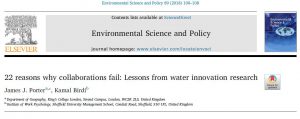New Research Output by Dr. James Porter: 22 Reasons why collaborations fail: Lessons from water innovation research
Research highlights:
- Bold and inventive solutions are urgently needed to safeguard the future use of water.
- Collaborative-innovations are increasingly championed but it’s often unclear what influences the success (or failure) of these efforts.
- Using an international systematic literature review of empirical studies, we identify 22 key themes.
- Yet the importance attributed to each theme, agreement amongst the studies reviewed, and compatibility of the themes, varies considerably.
- We caution against the uncritical use of different themes and call on researchers and practitioners to recognise the darker side of water collaboration.

Recommended reference: Porter, J.J.; Birdi, K. (2018) 22 Reasons why collaborations fail: Lessons from water innovation research, Environmental Science & Policy, 89, 100-108.
The paper is freely available at: https://doi.org/10.1016/j.envsci.2018.07.004
This research is first of a series of outputs produced as part of the Engineering and Physical Sciences (EPSRC) TWENTY65 – Tailored Water Solutions for Positive Impact – Grand Challenge programme. The next research outputs will critically examine the themes identified here by comparing them with the first-hand experiences of those working in the UK water sector (e.g. water companies, suppliers, regulatory bodies, and research institutions).

Abstract: Bold and inventive solutions are urgently needed to safeguard the future use of water. In response, collaborative-innovation is increasingly championed. If stakeholders including water utilities, supply-chain companies, research institutions and local communities work together, share their experiences and pool ideas, meaningful change could happen, it’s argued. But effective collaboration is far from easy. For every incentive that drives collaboration forward, another barrier blocks its path. Whilst the literature offers many possible factors that influence the success (or failure) of collaborative-innovations, it remains unclear which factors are most important, where the highest agreement and disagreement exists, and if accommodating one factor creates problems for another. This is important because its not always practical, nor necessary, to apply everything from the academic literature. In this paper, we report findings from an international systematic literature review that brings together a range of studies that cross the water collaboration and water innovation divide. We identify 22 broad themes that are spread (unevenly) across the entire collaborative-innovation process; highlight how the level of attention given to each theme varies greatly; and where disagreement exists. Our research provides practical insights on how to create more effective collaborative-innovations in water and where future research should be directed.